 Image search results - "Chiba" Image search results - "Chiba" |

JR Chiba Station and Yokosuka Line
|
|

At 2 pm, the 18 portable shrines gather at the Ohara Fishing Port. 大原漁港に参集
|
|

Monorail to Chiba Koen Station 千葉公園駅
|
|

Chiba Castle as seen from Kencho-mae monorail station.
|
|
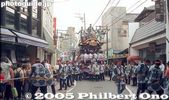
Held in July, Narita Gion Matsuri Festival has ornate floats pulled on the streets of Narita and to Narita-san temple. Pulling a float on the street
|
|

Keisei Narita Station. Getting to Narita is cheaper via Keisei Railway.
|
|

The biggest taiko drum festival in the Kanto region is held annually in April. Various taiko drum troupes perform for two full days on various outdoor stages in Narita, including the main stage in front of the Narita-san temple.
|
|

Entrance to Inohana Park
|
|

They run around while carrying a portable shrine.
|
|

JR Chiba Station platform
|
|

View of Chiba Park from monorail. 綿打池
|
|

Pulling the float, Narita Gion Matsuri
|
|
|
|

Keisei Narita StationThe Narita City Hall can be seen with the green, temple-like roof.
|
|

Path to Chiba Castle (visible on left)
|
|
|

JR Chiba Station
|
|

Chiba Park approach
|
|

Tired from walking, Narita Gion Matsuri
|
|

JR Narita Station
|
|
|
|

Chiba Castle and paper lanterns
|
|

They keep going round and round. Quite rowdy.
|
|
|

JR Chiba Station
|
|
|
|

Main road to Narita-san temple
|
|

Chiba Castle Sakura Matsuri lantern
|
|
|

White weeping cherry blossoms
|
|

Outside JR Chiba Station
|
|
|
|
|

Preparing unagi eel, Narita, Chiba. Also see the video at YouTube.Slicing it in half lengthwise.
|
|

Chiba Castle tower
|
|

A man who got bumped and fell is quickly brought to his feet by other people.
|
|

White weeping cherry blossoms
|
|

Outside JR Chiba Station
|
|
|
|
|

Striping off the boney spine.
|
|

Chiba Castle
|
|

Nice mikoshi.
|
|

Entrance to Chiba Monorail Station
|
|

Pink weeping cherry blossoms
|
|
|
|
|
|
|

Chiba Monorail Station
|
|

One thing unusual about this festival is that they carry the mikoshi with their hands and arms only, and not on their shoulders.
|
|
|
|
|
|
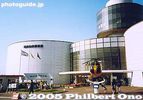
Museum of Aeronautical SciencesThe museum is right at the end of the runway of Narita International Airport.
|
|

Tossing a portable shrine, a common sight during the festival.
|
|

Chiba Station and monorail
|
|
|

Cherry blossoms and Chiba Castle
|
|
|
|
|
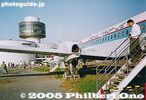
Old YS-11 prop plane.
|
|

About the Tokyo Motor Show...Makuhari Messe is near Kaihin Makuhari Station on the Keiyo and Musashino Lines. The huge show occupies the entire Makuhari Messe consisting of the North, East, Center, and West Halls, and Event Hall. Admission was 1200 yen. The show sees over 1.4 million visitors.
Although this is called the 39th Tokyo Motor Show in 2005, the first motor show was held in 1954 and called the 1st All-Japan Motor Show. The venue was Hibiya Park in Tokyo. In 1964, the show was renamed "Tokyo Motor Show." The show was held annually until 1973 when the oil shock occurred. It was so severe that organizers decided to hold the show every other year. No show was held in 1974. From 1975, the show was held every other year. 2005 is actually the 50th anniversary of the motor show.
In 1958, the venue changed to Korakuen Bicycle Racing Stadium. Also in 1958, the date was changed from spring (April-May) to fall (Oct.-Nov). In 1959, the venue was switched to Harumi at the domed Tokyo International Trade Center where it would remain until 1987 when it moved to Makuhari Messe in 1989. In 1970, foreign automakers participated in the Tokyo Motor Show for the first time.
In 1999, the show combined passenger cars and motorcycles. Also, in 1999, the show for commercial vehicles was omitted and instead to be held in a separate show in alternating years starting in 2000. The motor show for passenger cars and motorcycles would continue to be held every two years from 1999. So there would be a Tokyo Motor Show every year, but the purpose would alternate between passenger cars/motorcycles and commercial vehicles.
During the 1st motor show in 1954, when most of the vehicles displayed were for commercial use, the attendance was 547,000. In 1963, it exceed 1 million over 16 days. It hovered around 1.4 million in the years following. The record attendance was attained in 1991 with over 2 million visitors during 15 days. In 2003, the total attendance was 1.424 million.
In 2000, at the first Tokyo Motor Show dedicated to commercial vehicles, attendance was a mere 177,900 over 5 days. In 2004, attendance was 248,600 over 6 days.
The ubiquitous female companions, attendants, or models that we see today started appearing at the show from as early as 1957. They do not only decorate the show, but they also reflect the fashion of the times. Their hairstyles, wardrobe, skirt length, make-up, etc. The Tokyo Motor Show is not only a showcase for cars, it is also a fashion showcase. Therefore, in this online photo gallery, you will see not only cars, but also women. Enjoy!
|
|

Inside monorail
|
|
|
|
|
|
|
|
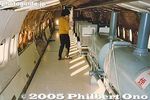
Inside the YS-11
|
|

This is where they offload fish.
|
|
|
|

JR Chiba Station
|
|
|

Narita Gion Matsuri
|
|
|
|
|
|

Ohara beach where the portable shrines will be carried into the ocean. 大原海水浴場
|
|
|
|

View from monorail
|
|
|

Narita Gion Matsuri
|
|
|
|
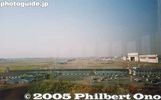
Museum's observation deck.
|
|

View from monorail
|
|

Ohara beach
|
|
|
|

Cherry blossoms and Chiba Castle
|
|
|
|

Chiba Station as seen from the monorail
|
|

A few photographers come early to secure the best positions.
|
|

White and pink weeping cherry blossoms
|
|

Corners
|
|
|
|
|

Chiba Station as seen from the monorail
|
|

They are soon followed by many more photographers.
|
|

About 30 weeping cherry trees ring the pond's perimeter.
|
|

Front view
|
|
|
|

Chiba Station as seen from the monorail
|
|

The crowd at the beach.
|
|

Chiba Park
|
|
|
|
|

Side entrance to Narita-san temple.
|
|

Shopping area near Chiba Station
|
|

At 3 pm, the first portable shrine is carried into the ocean. 汐ふみ(大原海水浴場)
|
|
|
|
|
|
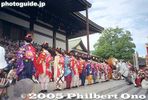
Offering prayers at Narita Gion Matsuri
|
|

Vending machines
|
|

Portable shrines from 18 shrines in the area join in the festival.
|
|
|
|
|
|
|

Ohara Hadaka Matsuri
|
|
|

Chiba Prefectural Capital
|
|

Statue of Chiba-no-suke Tsuneshige and Chiba Castle tower 千葉介常重Lord Chiba-no-suke Tsuneshige was the founder of Chiba Castle in 1126.
|
|
|
|
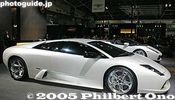
The best-looking lady at the show...A Lambo of course. Lamborghini, everyone's all-time, ultimate dream car. (Besides Speed Racer's Mach 5.) This is the Murcielago.
|
|
|
|

Statue of Chiba-no-suke Tsuneshige built in Dec. 2001 to commemorate Chiba city's 80th anniversary. 千葉介常重Lord Chiba-no-suke Tsuneshige was the founder of Chiba Castle in 1126.
|
|

Gathering at Narita-san temple
|
|
|
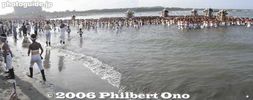
Many more portable shrines follow.
|
|

Most of the weeping cherries are planted along the pond's edge.
|
|

Statue of Chiba-no-suke Tsuneshige 千葉介常重Lord Chiba-no-suke Tsuneshige was the founder of Chiba Castle in 1126.
|
|

Prayers at Narita-san
|
|
|
|

Chiba Park weeping cherries
|
|

Stone wall at entrance
|
|

Narita Gion Matsuri
|
|
|
|
|

Boats for rent
|
|

Steps to front entrance
|
|
|
|
|
|
|

Deck
|
|
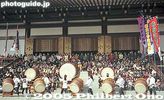
Main stage at Narita-san temple.
|
|
|
|
|

Castle tower
|
|
|
|
|
|
|

Roof tiles with the Chiba clan's crest
|
|
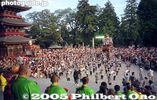
Narita-san during Narita Gion Festival
|
|
|

Ohara Hadaka Festival
|
|
|

The castle tower is built on an anti-earthquake foundation.
|
|
|
|
|
|
|

Exhibits inside the castle, a folk and history museum for the Chiba clan and Chiba city.
|
|
|
|

Main stage at Narita-san temple.On Saturday evening, the festival climaxes with a free show on the main stage. The best taiko troupes from Japan and overseas performed for 2 hours.
|
|

Top floor of castle
|
|
|
|
|
|
|

Lamborghini MurcielagoNo price was listed. But if you have to ask, then it's too expensive.
|
|

Balcony on top floor
|
|

This photographer forgot his shorts.
|
|
|
|
|
|

Unfortunately, the mesh fence ruins the view and picture-taking.
|
|
|
|

Narita Gion Matsuri
|
|

Drum troupe from S. Korea
|
|

The red fence is so low that anyone can fall over.
|
|

Gas station
|
|

Chiba Park
|
|
|

View of park grounds
|
|

Exhibition space
|
|
|
|
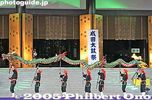
Taiko troupe from OkinawaThis group stole the show with a dragon dance, lion dogs, and eisa taiko drummers.
|
|

View of park grounds
|
|
|

Monorail track
|
|
|

Through the mesh
|
|

Taking a break.
|
|
|
|
|

Toward Chiba Port
|
|

From the beach, the portable shrines are paraded in town.
|
|
|
|
|

Also at night.
|
|
|
|
|
|

Festival poster for Sept. 23-24, 2004.
|
|
|
|
|
|
|
|
|
|

Lamborghini MurcielagoOnly with a Lamborghini would I tell any pretty woman standing in front of it to move away so I can see and photograph the car better. Actually, I'm not that rude, so I just waited until she went away.
|
|

Picnic area
|
|
|
|
|

Bekkoame candy stand
|
|

Arakiyama hill 荒木山A low hill is next to the pond. Some cherry trees are also on this hill.
|
|
|
|
|

Arakiyama hill 荒木山
|
|
|

Path to park exit
|
|

Photogenic weeping cherry シダレザクラ
|
|

Last group
|
|
|
|

Weeping cherry tree is "shidare-zakura" in Japanese.
|
|

"Shidare" actually means "drooping."
|
|

Monument for the Ohga Lotus, a 2,000-year-old lotus flower species discovered in Chiba by the late Dr. Ohga in 1951. 大賀ハス
|
|

Lotus Pavilion, the Ohga Lotus blooms around this pavilion during June and July. 蓮華亭
|
|

Inside Lotus Pavilion, pictures of the Ohga Lotus is displayed. 蓮華亭
|
|

Lamborghini Murcielago. Although this is called the 39th Tokyo Motor Show in 2005, the first motor show was held in 1954 and called the 1st All-Japan Motor Show. The venue was Hibiya Park in Tokyo. In 1964, the show was renamed "Tokyo Motor Show.&quoThe best-looking rear at the show...
|
|

Pond path
|
|

綿打池
|
|

綿打池
|
|

Chiba Koen Station 千葉公園駅
|
|

Chiba Koen Station monorail platform 千葉公園駅
|
|

This dance is called "Nuchibana" (flower lei) featuring a string of red and white flowers.Okinawan dancer wearing a kimono with her right arm exposed outside the sleeve. The dance is called "Nuchibana" (flower lei) featuring a string of red and white flowers. The dance expresses the feelings of a young woman in love.
|
|
|
|

Chiba Koen Station monorail
|
|
|

Dancer: Nariko Miyagi
|
|
| 1997 files on 8 page(s) |
1 |
 |
 |
 |
 |
|